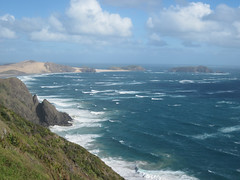“To hear a weathervane say yes.” This phrase was printed on an exhibit label for Walid Sadek’s installation at the 4th Auckland Triennial. It has haunted me ever since I viewed the exhibit.
The piece is comprised of two exhibition labels attached to the walls of a four-walled square room. The most substantial element is absence.
Fastened to the entrance, the first label read: Walid Sadek (b. 1966) Kozo Okamoto resides in Greater Beirut (2008-2009). The second label, attached to the far inside wall, read: Kozo Okamoto (b. 1947 – d. 1972, 1985, 2000) To hear a weathervane say yes.
Essentially a white room within a room, the installation was centered in the otherwise empty gallery space. The enclosure was empty—except for pencil scribbles around the perimeter of the cement floors, bulging into a circle in the center
Pencil drawings and printed words—that was it.
Lacking any visual while standing in the empty space, my mind quickly imagined a scrawny trembling finger of someone frail, as though lifting up from a newly-dug grave, reaching for something to grasp onto. This image—no kidding—came out of nowhere before I knew anything about the work. In some ways, I wished I didn’t know what I do now about the installation.
I learned the artist lives and works in Beirut. His work references the former Japanese Red Army militant Kozo Okamoto, one of three death squad terrorists, who orchestrated the bloody 1972 airport massacre in Tel Aviv in support of the Palestinian cause against Israel. The massacre’s sole survivor, Okamoto was released in 1985 from solitary confinement in an Israeli prison, and in 2000 was granted asylum in Lebanon.
According to the exhibition guide, the installation functions as both shrine and a tomb, “posing the question of how we memorialize such figures” and “asks us to encounter the overwhelming presence of this history in a journey inward.”
Knowing the political message lessened the work’s strength for me. It was/is the poetic ambiguity that etched itself deeply into my psyche. It seems to build on nothing but trace, memonic residue of sorts, a concept which appeals enormously to me as an artist.
Two other works that shivered me timbers …
Shilpa Gupta’s Singing Cloud, which consisted of 4,000 glistening black microphones lumped together and hung from the ceiling like a cloud. Fitted with multi-channel audio devices, the work emitted a strange mix of sounds—whispers, singing, snoring, wings flapping, raindrops. Gupta lives and works in Mumbai.
The Room with a Bird by Thailand native Bundith Phunsombatlert, who lives in New York. As I moved through a narrow space, an orderly grid of empty bird swings, suspended from the ceiling and activated by sensors, swayed while speakers amplified ambient avian-like sounds.
Living in Idaho, where access to international art is sparse, I appreciated how the Auckland Triennial explored issues relevant to the worldwide contemporary art. New Zealand represented only six of the 30 artists exhibited at five different venues in the Auckland’s Art Prescinct. When selecting artists, curator Natasha Conland traveled through Singapore, China and Japan, then on to Iran, Syria and Lebanon.
According to the exhibit catalog, her goal was to reflect on the impulse toward adventure and risk-taking in art today, challenging viewers to think about work that explores “existing material conditions, alternative solutions for living, physical freedoms for the body and political spaces without polarity.”
Heady stuff, way over my head, and yet … the wow factor rippled up and down my spine during my entire visit to the gallery.
I’ve had a chance to see incredible contemporary art in Christchurch, Dunedin, Gore, New Plymouth, Wellington and Auckland. What I’ve come to appreciate is how the NZ art scene is “out there.” That is, being isolated so deep in the Pacific, it seems the country bend over backwards to exhibit artists from the world as a way to inspire and challenge the artistic sensibilities of both the public and NZ artists.
But this exhibit alone shifted a big something inside me, not sure what yet. Revelation is always such a slow horse.


